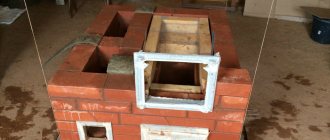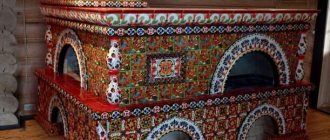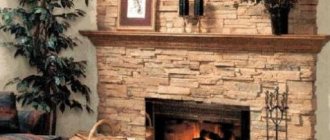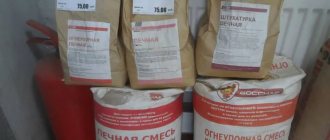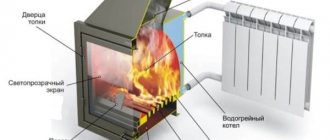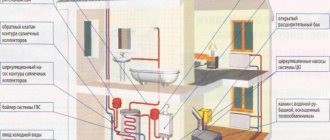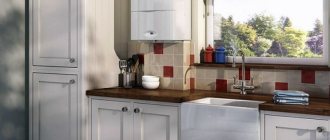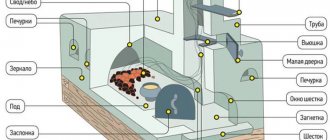Tiles for fireplaces and stoves are a special material. Operating conditions involving high temperatures impose certain requirements on the coating, which must be:
- Eco-friendly - when the plates are heated, the toxic compounds included in their composition will evaporate into the surrounding space;
- Heat-resistant, withstands heating up to 1000ºС. The letter “T” on the packaging indicates that the product can be used for lining fireplaces. The same is indicated by the presence of a symbolic tongue of flame with the numbers 1 or 2, which indicate the number of firings. The higher this value, the better;
- Thermally conductive and heat-intensive, since the main purpose of the stove and its coating is to heat the room;
- Moisture resistant. The water absorption coefficient should not exceed 3%. On the box this information is indicated by the symbol E followed by the percentage of moisture absorption;
- Rigid, at least 8 mm thick, which will protect the coating from deformation;
- With a coefficient of thermal expansion within 7-8%;
- Finely porous and resistant to mechanical damage - the fewer pores, the stronger (and more durable) the material. On the packaging, information about the degree of wear resistance is indicated as PEI, followed by Roman numerals. For furnace lining, IV or (preferably) V values are required;
- Resistant to fading and temperature changes;
- Antistatic;
- Attractive in appearance - the fireplace (stove) will become the dominant element of the interior. Marking “A” means that the element is made using computer technology, and this indicates a more accurate correspondence of individual slabs to the declared dimensions.
The most suitable facing tiles for stoves are matte, measuring no more than 25 x 25 cm. They are easier to install and maintain, and last longer.
What is and purpose
Refractory tiles are, according to the definitions given in GOST 28874-2004 and GOST R 52918-2008, a type of molded refractory materials (products), since they are characterized by certain geometric shapes and standard sizes available for all serial products.
The main purpose of tiles made from both natural finishing stones and artificial ceramic materials, regardless of its type, be it ceiling, facade or floor, is decorative, protective cladding of the surfaces of building structures, heating household, industrial equipment, including stoves , fireplace, without which a modern bathhouse, sauna, residential or country house is impossible.
Fireproof materials and their fire resistance
Ceramic heat-resistant tiles are multifunctional products that allow solving several problems facing customers - from builders constructing objects for various purposes to private property owners:
- Create a unique interior in a residential, country house, bathhouse, sauna, using fire-resistant tiles that are suitable/liked in appearance, texture, color, pattern for decorative cladding of the external surfaces of stoves, fireplaces, including fire-resistant cuts and offsets; as well as stationary grills and barbecues located in personal plots.
- To provide protection against overheating of heating equipment, to reduce the possibility of thermal damage to people using it at home and at work.
- Increase the heat capacity of stoves and fireplaces, increase the uniform heat transfer of heating units by creating even, smooth outer surfaces that effectively act as heat shields.
Properties and characteristics
Any types (types) of fire-resistant tile products, regardless of materials, methods of their manufacture, must have the properties required by construction, fire safety, and sanitary standards:
- Fire resistance – the ability to withstand short-term temperature exposure up to 1000 ℃.
- The maximum heating temperature on the outer surface during operation under normal conditions, which, depending on the category and purpose of the furnace equipment, varies in the range from 100 ℃ (moderate heating) to 120 ℃ (high temperature heating). The temperature limits for each type of refractory tile are determined during testing and are indicated in the accompanying technical documentation for each batch of products.
Determination of fire resistance limit
- The absence of toxic substances in the composition, including those formed during high-temperature heating, which is solved by the use of fire-resistant natural raw materials or natural materials without harmful impurities.
- Thermal conductivity, heat capacity, important properties that make it possible not to reduce the heat transfer of furnace equipment made of refractory bricks.
- Low porosity, high density, low water absorption - all these properties are inextricably linked.
- Fracture strength, point impact load.
- Resistance of paint layers and enamel coatings to external influences.
- Resistant to fading of original colors and designs.
Specifications:
Advantages of tiling
Any material intended for the construction and decoration of a fireplace surface has its advantages and disadvantages; the positive features of tiles, as well as ready-made installations with such finishing, include:
- Fire resistance. Depending on the type of tile chosen, it can withstand heating temperatures of 600 degrees Celsius or higher.
- Resistance to sudden changes and drops in temperature is noted. The surface of the products practically does not expand, completely ensuring the tightness of the furnace structure;
- The cladding becomes a kind of surface protection, it allows you to preserve, accumulate, accumulate the generated thermal energy, increases efficiency and heat capacity to the maximum (80+ percent);
- The appearance of the product becomes very interesting, stylish, and unique. A simple, monochromatic, faded brick, cast iron, or steel surface is hidden;
- Resistance to impacts, deformations, melting, scratches ensure that over the years the product will not lose its original attractiveness, well-groomed appearance, bright colors, colors;
- Simple care consists of simply periodically wiping the surface from dust, soot and soot; for this there is no need to use chemical or special expensive products;
- The price of tiles can be different, the most affordable is ceramics, the intermediate option is artificial stone, majolica, tiles and natural minerals are considered the most expensive.
If you don’t have the energy or time to cladding your stove, electric fireplace, or bio-fireplace with your own hands, you can alternatively buy a completely finished cladding in our online store in any color, style, design, size, or arrangement. Delivery is carried out on favorable terms throughout Moscow and the region, prices for an assortment of domestic and foreign manufacturers are always acceptable.
Types of heat-resistant tiles
Tiles for stoves and fireplaces are varied. Main types:
- Terracotta;
- Majolica;
- Tile;
- Clinker;
- Tiles;
- Fireclay;
- Porcelain tiles;
- Natural marble;
- Fake diamond.
Terracotta
Similar tiles for fireplaces and stoves are characterized by a rough surface, imitating brick and natural stone. It can be used indoors or outdoors. Terracotta heat-resistant tiles are successfully used in saunas and baths. It is made from dense pressed clay.
The stove in the cottage is lined with Terracotta tiles.
Warm wall.
Important material characteristics:
- Impact resistance and durability;
- Resistance to sudden temperature changes;
- Fire resistance - it is produced at a temperature of 1100ºС;
- Steam and water resistance;
- Good adhesion to any adhesive base;
- High heat transfer, which is due to the textured surface, and thermal expansion corresponds to a similar characteristic of oven bricks.
Video:
Majolica
Majolica is a tile made of fired clay, covered with glaze. Often a decorative design is applied to the surface. The elements are made by hand, the high price corresponds to the labor costs. Sometimes it is combined with Metlakh tiles. Read a detailed article about majolica.
The fireplace is lined with tiles with a majolica pattern.
Fireplace cladding with majolica.
Tile
A ceramic stove (tile), even a heat-resistant one, is sensitive to sudden changes in temperature. For ovens, small matte elements (up to 20 x 25 cm) are preferable - the glaze will become cracked after a while. Usually, old tiles are used for stoves, which you don’t mind throwing away.
Tile is not recommended for rooms where the temperature can drop to sub-zero values: crumbling is possible.
Tiling the stove.
Laying such elements on clay or cement mortars is unacceptable, since the water absorption coefficient of ceramics is zero. They require special heat-resistant glue or mastic. There is a way to install without glue - in metal frames. The video shows a master class on tiling a chimney:
Clinker tiles
Such tiles for a fireplace or stove are obtained by mixing fireclay powder, several types of slate clays and other additives. The surface of the slab is not glazed. The surface color varies from white to beige, from orange to red, from light yellow to chocolate brown. The final tone is set by mineral dye.
The clinker board has a higher density than terracotta or majolica, which results in lower water resistance and better frost resistance. These characteristics make it possible to use such a coating where temperature changes are observed.
We recommend: Operating instructions for the Baxi gas boiler: installation, configuration, as well as the first start-up and maintenance of this device
It is not recommended to be used for finishing those stoves whose internal walls are lined with stove bricks. The coefficient of thermal expansion of materials and their structure vary too much.
Tiles
Tiles are box-shaped, have a smooth or textured surface, and are covered with glaze or enamel. It is made and painted by hand, which determines the high cost of the material.
When installed, individual elements form a pattern. The coating is characterized by high heat transfer and the highest environmental friendliness. Cost - from 30,000 rubles per square meter.
The stove lined with tiles is a real work of art.
Covering the stove and apron with handmade tiles. The tile is made of white clay and covered with glaze.
Fireclay tiles
Fireclay tiles with a single layer of brown coating and blue glaze.
Acid-resistant stove tiles are an expensive material, handmade from refractory clays and stone flour added to enhance strength. Firing occurs at a temperature of 1300ºС. The advantages of fireclay slab are that it:
- Resistant to extreme – both low and high – temperatures;
- Has absolute fire resistance;
- Does not crack;
- Withstands long-term static loads;
- Does not wash off;
- Has a low slip coefficient;
- Neutral to aggressive media (acids and alkalis, solvents and petroleum products, etc.);
The stove-bed is finished with fireclay tiles.
- Much thicker than tile;
Available in single and twin versions, but the latter increases the volume of the oven. For household needs, a single one is sufficient.
Fireclay tiles for a fireplace do not require additional insulation of the base surface: they do not need to be grouped with coatings such as natural stone or gypsum.
Porcelain tiles
Porcelain tiles used for facing a fireplace are a mixture of quartz sand, several types of clay, granite and marble chips. Metal oxides and salts act as dyes. The coating is environmentally friendly.
The structure of porcelain tiles for stoves is non-porous and dense. It is resistant to low and high temperatures.
The stove in the dacha is finished with porcelain stoneware.
Porcelain tiles can imitate all of the above types of coatings and natural stone. It retains color even in direct sunlight. The thickness of the elements is from 9 to 12 mm. Heat-resistant porcelain tiles are attached using hot-melt adhesive. If the stove is located outside, use frost-resistant glue.
Marble
Beautiful natural material suitable for expensive interiors. A square meter of 20 mm slab costs about $110. Plus, you need to pay for the services of a designer, precise cutting and labor-intensive work of a craftsman. Read the details of facing a fireplace with marble in a separate article.
Fake diamond
A good option for those who do not know how to lay tiles. A stone of different sizes allows you to hide the unevenness of the stove. Even a woman without experience can handle its styling. Before laying, be sure to clean the back side of the tiles from mortar buildup.
The stove is finished with different-sized artificial “torn” stone. Laying was done using heat-resistant Hercules glue. Metal elements are painted with Tikkurila Termal Alluminium paint.
From serpentinite and serpentine
Its color range includes an infinite number of shades of green - from very light, almost yellow, to the darkest.
- Aesthetics : beautiful appearance.
- Durability : able to withstand high pressure, durable.
- Heat capacity : quickly accumulates, but slowly and gradually releases heat, so the steam in a bathhouse lined with a coil turns out soft and light.
- Healing properties : relieves headaches, treats colds, improves blood circulation - these properties are due to its chemical composition.
These tiles are well suited for lining sauna stoves.
From jadeite
- Aesthetics: attractive appearance, rich palette of rich shades of green with various inclusions.
- Durability: Able to withstand high pressure and temperature, durable.
- Eco-friendly: natural material containing useful minerals.
- Heat capacity: accumulates heat and releases it for a long time, which is an undeniable advantage in a steam room.
When heated, jadeite does not emit any harmful substances. Only useful compounds evaporate into the air, including metasilicon acid, which has strong anti-inflammatory properties.
Using jadeite tiles for decoration, you can greatly enhance the healing and preventive properties of your steam room.
From Soapstone
- Heat resistance: can withstand temperatures up to 1200° without changing its physical and chemical properties.
- Heat capacity : it can store heat for up to several days.
- Safety : no matter how hot it is, soapstone does not burn, even if you touch it with your bare skin.
- Useful properties : the wavelength emitted by heated soapstone is the same as the wavelength of thermal radiation from the human body. This means that in a bathhouse tiled with this stone, you will feel as comfortable as possible. Soapstone also ionizes the air, improves metabolism and improves immunity.
Requirements for stove tiles
Tiles for stoves and fireplaces should be:
- Heat resistant. If the letter “T” is on the packaging, the facing material can withstand heating up to 1000 degrees. Heat resistance is also indicated by the flame, the image of which comes in a “set” with numbers: 1 or 2.
Mathematical symbols indicate the number of firings of the tile - the higher the number, the more heat-resistant the product.
- Strong. Tiles whose thickness is less than eight millimeters are not suitable for cladding fireplaces.
- Thermally conductive. A material, even the most heat-resistant one, is of little use if it does not share the “temperature” with the room.
- Dense. Fine porosity is an important criterion that determines the suitability of tiles for decorating stoves.
- Wear-resistant. Directly depends on the previous point. Defined by the PEI standard. This classification assumes the presence of five categories (IV). For cladding stoves and fireplaces, you can use slabs marked IV and V.
- Moisture resistant. And this parameter is related to density. The tiles should not have more than a three percent water absorption coefficient.
- Eco-friendly. Heating is always accompanied by the evaporation of certain substances. If the material contains toxic substances, they will definitely enter the human body. Corresponding to a certain thermal expansion framework. More precisely, the limits are 7-8%.
Of course, in addition to technical criteria, there are also decorative requirements. Of course, no one obliges you to decorate stoves and fireplaces with beautiful and spectacular tiles, but it is impossible not to recommend using an attractive facing material.
Granite
A type of rock with igneous origin. The main distinguishing feature is increased strength. It is cut into slabs with a thickness of up to 2-3 centimeters, otherwise the products turn out to be too heavy.
Processing helps to obtain matte or glossy textures on the surface.
Stove tiles - nuances when facing
To ensure that fire-resistant tiles serve you as long as possible, be sure to use heat-resistant adhesive in your work. Choose formulations that are non-volatile compounds . This will save you from having to ventilate the room and work with open windows. To avoid poisoning during cladding, it is better to purchase an odorless solution.
There are some nuances when decorating outdoor stoves. So, the glue must be not only heat-resistant, but also moisture-resistant. The materials are laid on a pre-plastered surface, and the cut tiles are installed last. Whatever type of material you choose, the most important thing is to follow the correct installation technique, which will extend its service life.
Tiles
The variety is known for its colors and shapes in large quantities. The design is more like boxes.
It is characterized by the presence of small sides on the reverse side, which are sometimes called rumpa. Thanks to such solutions, furnaces increase efficiency by 15%.
In the process of laying tiles, it is impossible to avoid some deviations, because manual labor becomes the basis for everything.
It is important to calculate the required number of tiles in advance to avoid problems and additional waste of time.
Other materials include fireclay tiles, porcelain stoneware and earthenware. Artificial stone has also become widespread, although not as widespread.
In terms of strength, these are the best options, although the cost cannot always be called affordable.
Selection rules and criteria
The choice of refractory material for the external cladding of a fireplace, stove in a bathhouse, private residential, including a country house should be carried out primarily taking into account whether it is suitable in its properties, technical characteristics, chemical composition for the type of surface on which it is necessary to lay heat-resistant tiles.
Of course, the appearance is also important, the optimal combination of patterns and colors of the selected fire-resistant tile with the main color scheme of the interior design of the sauna, kitchen or living room is imperative; it is necessary to decide whether its front surface will be matte, glazed, flat or embossed.
Metlach
The standard size of such tiles is 10 by 10 centimeters. Various shapes together with original design become the main advantages of the product.
If high humidity and elevated temperatures remain indoors, this is a suitable option for finishing.
In terms of performance characteristics, the product resembles porcelain stoneware.
Tiling the stove: features of the process
The stove has long served people, creating coziness and comfort in the home. The appearance of the stove is the calling card of the entire house. Ceramic stove tiles can transform any stove, and this one will help you choose one.
Ceramic stove tiles have been used in stove finishing for many hundreds of years.
Even today, despite the emergence of many different materials and technologies, it has not lost its leading position, thanks to quality, reliability and good price.
It has high strength characteristics and can easily withstand heavy loads during operation. Concrete is far behind ceramic tiles in terms of performance; it is less durable and inferior to ceramics in terms of wear resistance.
Installation of ceramic tiles is quite simple and requires a minimum of tools and skills.
- The high fire resistance of ceramic tiles is an undoubted advantage when finishing stoves and fireplaces.
- Made from environmentally friendly and safe, natural materials. Clay, as the main material for production, is completely safe and does not emit any substances harmful to health.
- Caring for tiles is very simple and does not require much effort or special measures. It will be enough to simply wipe the ceramic tiles with a damp cloth from time to time.
- There are very few disadvantages to ceramic tiles for stoves. The only thing that can be highlighted is that ceramics is a rather hard material, so if hit by a hard object it can easily be cracked.
- This small drawback can be ignored; this facing material is very practical and convenient for finishing the stove.
Tile
The heat resistance of the structure is sufficient to withstand any temperature. Compared to analogues, the strength of the glazed surface leaves much to be desired.
Over time, the product cracks when exposed to high temperatures. Small sizes with a matte surface are the optimal combination when creating stoves.
Do-it-yourself tiling of fireplaces
For work you need the following materials :
- tile;
- sand;
- cement or clay (for mixing the solution);
- water;
- crosses and wedges;
- nails and hammer;
- self-tapping screws;
- drill;
- level;
- putty knife.
Preparatory work
Work begins with surface preparation. If this is not done, the cladding will begin to peel off.
The preparatory stage occurs as follows:
- Inspect the current coating and remove completely.
- Using a plumb line, it is necessary to determine the thickness of the new coating, which can level the plane.
- Level uneven surfaces with a primer or other compound.
- Using a chisel and hammer, deepen the seams at least 1 cm.
- Drive in nails or screws.
- Place a net on the surface. To prevent it from falling off, you can put washers on the heads of the screws.
- Technology for laying tiles on a fireplace
After the surface of the fireplace is prepared, you need to make a solution. The process depends on its composition:
- Clay. The clay is passed through a sieve. A homogeneous composition without lumps and debris is obtained. Then the clay is mixed with water and left for a day to achieve the required viscosity. Sand is added to the mixture. Proportions are calculated in advance using clay and sand balls.
- Cement. Sand and cement are added to the container in a ratio of 1/3. Gradually add water to the mixture. The cement solution is mixed to a homogeneous consistency.
To tile a fireplace with your own hands, you must first lay it out on the floor to determine the order in which it will be laid out.
You can post it in two ways:
- using crosses and wedges to get the same distance between the plates, or end-to-end.
- The second option of framing the fireplace stove with tiles is simpler, but it requires an ideal eye.
Laying begins from the lower left corner. First, the fireplace is covered with mortar using a spatula, then the building material is pressed in a circular motion to the surface. Each row is checked for parallelism to the previous one using a building level.
If crosses and wedges are used, they are inserted as work progresses.
- To fill, you can use a plastic bag with a small corner cut off. By squeezing out the required amount of mortar, you need to fill all the cracks between the tiles.
- After completely covering the fireplace with gypsum tiles, at least three days must pass for the compositions to dry. After time, a protective wax mixture is applied.
Functions
The furnace lining performs a number of specific functions:
- reducing the time required to heat the room;
- ensuring ease of maintenance of the device - cleaning tiles is much easier than, for example, a plastered surface;
- attractive decor;
- increase in heat transfer and heat capacity of the furnace;
- psychological aspect - according to most psychologists, the presence of a traditional stove in the house has a good effect on the general atmosphere in the home, as well as the mood of others.
Where is it used?
Fireproof tiles for fireplaces and stoves are used primarily as a decorative element for the surfaces of heating devices. Thanks to tiles, these objects can be transformed into a real work of art, giving a stove or fireplace a personal touch, or finishing in accordance with certain cultural traditions.
An excellent example is the Russian stove, which is still used in homes directly for its intended purpose or as a bright element of room decor.
Tiles are not used for finishing the space around the stove, working and internal surfaces.
All types of fire-resistant tiles must have a quality certificate. Only with supporting documentation can we say that the material will meet the declared characteristics.
Terracotta
Kaolin clay is used for its production. This is a special material that gives the final product high heat resistance.
Available in several models:
- Glazed.
- With a layer of gloss for decorative purposes.
- With the addition of pigments of natural origin.
High heat resistance and adhesion to any surface remain distinctive features for products of any variety. This is a popular treatment option that is characterized by low cost and simple finishing.
Selection rules and criteria
The choice of refractory material for the external cladding of a fireplace, stove in a bathhouse, private residential, including a country house should be carried out primarily taking into account whether it is suitable in its properties, technical characteristics, chemical composition for the type of surface on which it is necessary to lay heat-resistant tiles.
Of course, the appearance is also important, the optimal combination of patterns and colors of the selected fire-resistant tile with the main color scheme of the interior design of the sauna, kitchen or living room is imperative; it is necessary to decide whether its front surface will be matte, glazed, flat or embossed.
Invaluable assistance in solving this complex issue can be provided by stove craftsmen, interior finishing specialists who usually need a visual assessment of stove equipment, as well as employees of trade organizations that sell tile products.
When making your own choice, you should take into account the following criteria, which must be met by high-quality fire-resistant tiles manufactured in accordance with the technical conditions of mass production:
The average thickness of a piece is 6–8 mm.
Thinner tiles are fragile; thicker tiles may cause problems both during installation and during subsequent operation of the furnace equipment due to a drop in heat output into the air in the room.
The geometric dimensions of the tiles, both in one package and in the batch of products selected for purchase, must be identical, otherwise the installation process will become more complicated and the appearance of the finished surfaces will suffer.
Checking the dimensions and evenness of refractory tiles is simple: just touch two products with the front side, then the inside side to each other, to understand how much they coincide, whether there is a gap between them, indicating the curvature of the surfaces.
The front side of the tile should not have any mechanical damage or traces of manufacturing defects - cavities, unevenness on a smooth surface, incomplete glazing; as well as discrepancies, changes in color, pattern within the selected batch of goods.
Cracks and chips found during selection on individual piece products are an alarming signal that the product is very fragile and easily damaged, so there is a high probability that during operation at high temperatures the front side of individual refractory tiles may burst, or part of the purchased product will suffer further damage. during transportation to the place of masonry work.
When choosing, you should not mix fire-resistant tiles of different types and manufacturers, since their properties and technical parameters, despite their external similarity, can vary greatly, and this can have a fatal effect during operation, for example, due to different coefficients of thermal expansion, which is often leads to the collapse of fragments of the furnace lining.
The best choice is fire-resistant tiles with decorative elements in the same color and shade range from the same manufacturer, which do not differ in properties or technical characteristics.
When ordering or purchasing, a surplus of 10-15% in area is required, since part of the material will inevitably go to waste when trimmed, and the remaining amount will become a reserve for replacing accidentally damaged tiles during long-term operation.
Marking
Using the special symbols that are indicated on the packaging of the tiles, you can find out whether a given sample is suitable for finishing stoves or not.
It is customary to distinguish the following signs:
- The water absorption coefficient is indicated on the box and is designated by the letter “E”. It should not be more than 3%. Granite has the highest moisture resistance: 0.5%.
- Information about porosity is given by the PEI symbol and the following numbers on the packaging from I to V. For stoves and fireplaces, level IV or V should be selected.
- Marking “A” or “B” indicates that the design of this product was developed on a computer. Tiles with the letter “A” are distinguished by more accurate compliance with the stated dimensions.
- The designation “EN 122” and the letters A to D indicate the level of resistance of the tile to chemical attack.
Travertine
Formed from limestone in natural conditions. Contains iron oxides, which cause the stone to age and turn yellow over time.
Thermal conductivity is quite low, which causes a reduced cooling time for the furnaces. But wear resistance remains high.
Dimensions
To make it convenient to work with tiles for lining stoves, their dimensions should not be too large. The optimal size is 25x25 cm, and the thickness is no more than 8 mm. For porcelain stoneware and clinker, no more than 6 mm is sufficient.
Such parameters will ensure sufficient thermal conductivity and strength of the entire installation. In addition, these sizes are much easier to work with.
Larger tiles can be made to order, for example from porcelain stoneware, but they are quite heavy and may not support their own weight, and also require more trimming and sizing. Tiles are also available in smaller sizes, for example, 10x10 cm.
However, it is used much less often for the same reasons as the large one - it is inconvenient to work with.
Terracotta material
It will help to successfully cover the stove with tiles on all sides; for this it is created from a special type of clay. It is called kaolin grade. They love to use it for cladding various types of stoves or fireplaces.
This modification has been known for a long time and has earned trust due to the duration of its use. It offers many shades and easily fits into any design ideas.
Design
The determining factor when choosing a stove cladding design is not the type of material, but the interior of the room in which it is located. A characteristic feature of the design of facing tiles specifically for stoves is the almost complete absence of geometric patterns.
It is not found in almost any style.
But the design of such products is replete with complex ornaments:
Floral patterns, characteristic of majolica or tiles, can be used in almost all styles - from classic to modern. Faience with its famous blue and white Gzhel color scheme would also be appropriate.
For a classic interior, you can choose porcelain stoneware; its possibilities are almost limitless. With it you can create entire paintings.
A modern interior does not imply too colorful decoration. Elegant monochromatic tiles with small splashes of decor would be more appropriate here. Various imitations of malachite and marble, as well as wood, will look good.
In a hunting lodge or country cottage, you can use natural stone. In order not to reduce the cost of the interior, you should not mix natural material with other types of finishing; it works well alone.
Real stoves are rarely found in techno or futurism style interiors. However, if elements of such design trends are still present, a plain tile would look good here.
In a country house, terracotta and clinker would be appropriate. Images of plants and flowers in the Khokhloma style will be especially good.
Colors
The color of the tiles is selected in accordance with the overall interior, as well as depending on the material:
For example, the color range of natural marble is very diverse. Due to the content of various impurities in the rock, the stone can take on the most unusual colors. In nature, there are white, black, green, blue, blue, red, gray, beige and even lunar marble.
Some colors are extremely rare and therefore more valuable.
Granite is less diverse: despite the fact that in nature there are a huge number of different shades of granite, they can all be divided into three main groups: gray, black and brown.
Travertine has a slightly richer color range. The most common colors in nature are white, beige and yellow. Red and dark brown stones are quite rare in nature and therefore especially valuable.
Therefore, to add additional aesthetics, the tiles are coated with special paint.
As for ceramic products, there are no restrictions on choice. The color range of clinker, for example, pleases with its diversity: from neutral white to calm beige, all shades of yellow and red, as well as light and dark brown.
Some types of tiles are tinted already at the production stage, and there are those that are coated with colored paint after they are manufactured.
